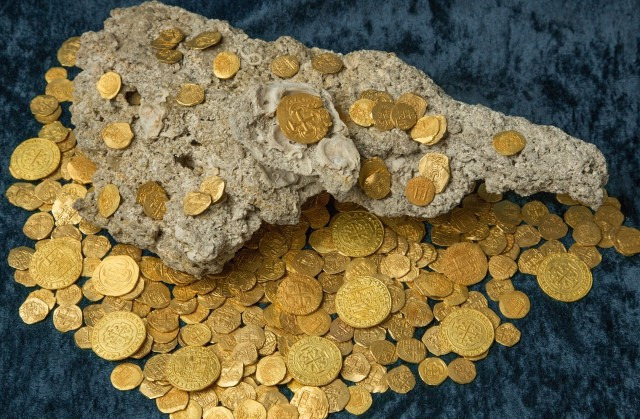Florida's Treasure Coast has truly earned its name this summer.
Less than a month after a group of treasure hunters uncovered $1 million worth of 60 gold coins from a 300-year-old shipwreck off of Florida's coast, they announced a second discovery of over 350 gold coins from the same site.
Except this one's worth a whopping $4.5 million.
Florida company Queen Jewels made the monumental discovery on July 31, which also happened to mark the 300th anniversary of a shipwreck of 11 Spanish ships that sank that day in 1715.
Previous excavations have turned up other important pieces from the shipwreck, giving the region of the Florida coastline its name. This one, however, was a big one.
"The historic find is what treasure-hunting dreams are made of," said Brent Brisben, the owner of Queen’s Jewels, in a press release.
The rarest and most valuable coins discovered were nine "Royals," which date to 1715 and were designed specifically for Phillip V. King of Spain. The newly-discovered Royals represent 30% of all Royals known to exist, Brisben said.
The coins were found in shallow water — just 6-feet-deep — just off the coast of Vero Beach, meaning beachgoers there have likely been swimming alongside the coins for years.
“These finds are important not just for their monetary value, but their historical importance,” said Brisben. "One of our key goals is to help learn from and preserve history, and this week’s finds draw us closer to those truths."
The state of Florida is legally entitled to 20% of the recovered artifacts for the purposes of displaying them in a Tallahassee museum. The rest will be split between Brisben, his co-captain and the diver who discovered the artifacts.
The ships, packed with treasures from the New World, had set off from Havana, Cuba, bound for Spain, on July 24, 1715. They were caught in a hurricane on July 31 and shipwrecked on Florida's Atlantic coast.
Nearly 1,000 people died in the wrecks and another 1,500 swam to shore. Salvage efforts on the ships began immediately and officials at the time reported that the treasure had been fully recovered, halting Spanish recovery of the treasure.
The salvage on the 1715 Fleet began in the late 1950s after an Ohio man found coins on the beach after a hurricane and decided to find out where it came from, the company's website says. Using a metal detector, he found the coins and "realized that just beyond the breaking waves must lay one of the long forgotten treasure ships of 1715."
Sure enough, he was right.
Fuente: mashable.com
